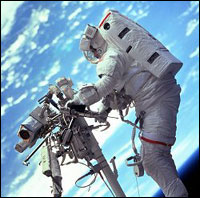| Main Menu > 6: Space Weather > Solar Flares |
|
NASA's RHESSI spacecraft aims to unravel an explosive
mystery: the origin of solar flares.
June 12, 2001—Astronauts love space walks. Floating weightless hundreds of kilometers above Earth, the terrain below racing by at 17,000 mph—no space traveler wants it to end. But it only takes two words to send one of those brave explorers racing back to their craft: "Solar flare!" "Solar flares are the biggest explosions in the solar system," says Robert Lin of UC Berkeley's Space Science Lab. "They erupt near sunspots with the force of a hundred million hydrogen bombs." Astronauts caught spacewalking during a solar flare or one of their cousins, a coronal mass ejection, can absorb a radiation dose equivalent to 100 chest x-rays—reason enough to dash for shelter. Flares pose little direct danger to Earth dwellers because our planet's atmosphere protects us from their deadly radiation. But unpredictable solar explosions do affect our lives. They can disable satellites, scramble aircraft navigation, and interrupt high-frequency radio communications for hours. "One of the most amazing things about solar flares," says Brian Dennis of NASA's Goddard Space Flight Center, "is the efficient way they accelerate subatomic particles to energies exceeding 109 eV." As much as 50% of the total explosion energy emerges as electrons and atomic nuclei traveling at nearly the speed of light. "Flares operate much more efficiently than any particle accelerator we've been able to build here on Earth." "How do flares do that?" he asks. We don't know, but terrestrial particle physicists would love to find out. What ignites solar flares? How do they unleash so much energy so quickly? And is it possible to predict when they will happen? Such questions have vexed astronomers since 1859 when Lord Carrington spotted a solar flare for the first time. "I was [counting sunspots on a projected image of the Sun]," he recalled, when suddenly "two patches of intensely bright and white light broke out" near a remarkably large sunspot group. "Flurried by the surprise," Carrington rushed from his telescope to call a second witness, but by the time he returned minutes later the outburst had vanished. Solar Flares continues in PDF form:
Solar Flares continues on the Web:
|
|||||
©2002 UC Regents
